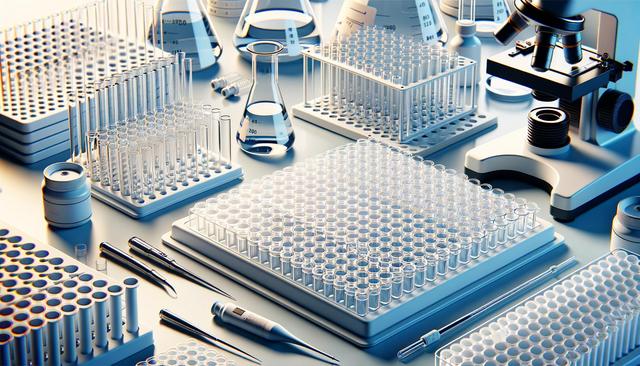
White 96 Well Plates: Compare Costs, Brands, and Laboratory Applications
Understanding the Functionality of White 96 Well Plates
White 96 well plates are essential tools in many laboratory settings, particularly in applications involving luminescence-based assays. The white coloring of the plates enhances signal detection by reflecting light, which can significantly improve sensitivity in experiments where signal strength is a critical factor. These plates are commonly used in molecular biology, biochemistry, and pharmaceutical research. The structure of a 96 well plate supports high-throughput screening, enabling researchers to conduct multiple parallel analyses efficiently. Whether used for enzyme activity assays, cell proliferation studies, or reporter gene analysis, the design of white 96 well plates offers consistent performance and reproducibility in results.
The wells are typically arranged in an 8×12 format, and their uniformity is crucial for automated systems and plate readers. Researchers often choose white plates over clear or black alternatives when working with low-light signals, as the reflective surface minimizes signal loss. This makes them particularly suitable for chemiluminescent and bioluminescent assays. Selecting the right plate type for specific laboratory applications can directly impact the accuracy and reliability of experimental outcomes.
Key Laboratory Applications of White 96 Well Plates
White 96 well plates are favored in a variety of scientific disciplines due to their specialized features. Their high signal reflection capacity makes them ideal for luminescence-based detection systems. Some of the most common applications include:
- Luciferase reporter gene assays
- ATP quantification
- Cell viability and cytotoxicity testing
- Enzyme-linked immunosorbent assays (ELISA) with luminescent detection
These plates are also compatible with robotic handling systems, which is beneficial for laboratories conducting automated high-throughput screenings. In drug discovery, researchers use them to test the effects of various compounds on biological targets. Additionally, the plates are suitable for multiplex assays, where multiple analytes are measured in a single run, offering better efficiency and data consistency. Their compatibility with standard plate readers further supports their widespread use across different labs and experimental setups.
Comparing Costs of White 96 Well Plates
When evaluating white 96 well plates for your lab, cost is an important factor to consider. Prices can vary significantly depending on material quality, surface treatment, and packaging quantity. Basic models may be available at lower prices, while plates with specialized coatings for cell attachment or reduced background noise come at a premium. Bulk purchasing typically reduces the per-unit cost, making it a viable option for labs with high usage rates.
A few considerations when comparing costs include:
- Surface type (e.g., high-binding, low-binding, tissue culture treated)
- Sterility and packaging (individually wrapped vs. bulk)
- Material durability (polystyrene vs. polypropylene)
Budget-conscious labs may opt for non-treated plates for general assay work, while those conducting more sensitive tests might invest in high-performance variants. It’s essential to align the cost with the intended application to ensure both efficiency and financial sustainability in laboratory operations.
How to Choose Between Different Brands of White 96 Well Plates
Choosing the right supplier or manufacturer involves more than just comparing prices. Performance consistency, quality standards, and customer support are key differentiators among brands. While some companies are known for producing plates with exceptional optical clarity and uniform well volumes, others may emphasize eco-friendly materials or innovative packaging solutions that reduce waste.
When evaluating different options, consider the following:
- Reputation for product consistency and quality assurance
- Availability of technical data and certification (e.g., ISO, lot traceability)
- Compatibility with lab instruments and automation systems
- Customer reviews and peer recommendations
Some labs also value brands that offer customizable formats or plates with barcoding for efficient sample tracking. Ultimately, choosing a well-regarded provider can lead to better experimental outcomes and less variability between batches.
Factors to Consider for Your Laboratory Needs
Selecting the appropriate white 96 well plates requires consideration of several laboratory-specific factors. Start by identifying the primary application—whether it’s luminescence assays, compound screening, or cell culture. The assay type often dictates the necessary surface treatment and optical characteristics. Labs focusing on cell-based assays may need plates with tissue culture-treated surfaces, while those conducting biochemical assays might prioritize plates with high-binding capabilities.
Additional factors to evaluate include:
- Compatibility with existing equipment and protocols
- Plate format and dimensions (standard ANSI/SBS compliance)
- Batch-to-batch consistency and availability
By aligning plate specifications with experimental objectives, labs can improve the reliability of their data and streamline workflows. Cost-efficiency should also be balanced with quality to avoid compromising results. Regularly reviewing product performance and supplier offerings can help ensure the chosen white 96 well plates continue to meet evolving research needs.
Conclusion: Selecting White 96 Well Plates for Optimal Lab Performance
White 96 well plates are integral to many laboratory workflows, particularly those involving luminescent detection methods. With a wide range of options available, comparing costs, brands, and specific features ensures that labs can make informed decisions tailored to their scientific goals. By evaluating key factors such as assay compatibility, material quality, and supplier reputation, researchers can select plates that provide both value and reliability. Whether for routine assays or advanced research, the right white 96 well plate can enhance data accuracy and support efficient lab operations over the long term.


